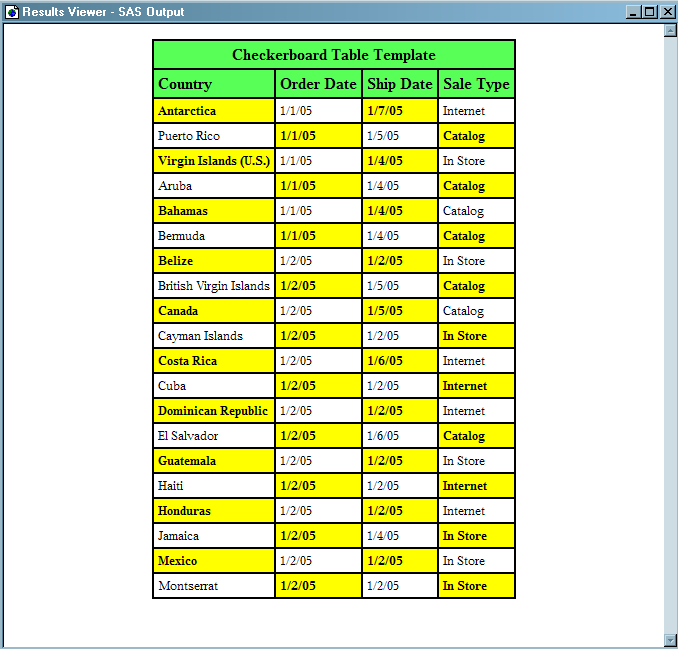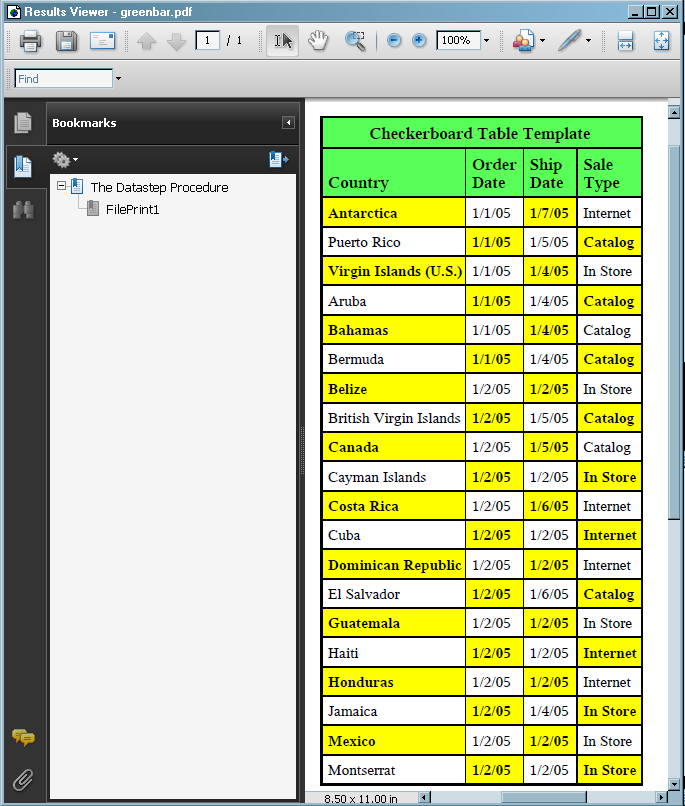TEMPLATE Procedure: Creating Table Templates
- Syntax
 Procedure SyntaxCELLSTYLE AS StatementCOLUMN StatementCOMPUTE AS StatementDEFINE StatementDEFINE COLUMN StatementDEFINE FOOTER StatementDEFINE HEADER StatementDEFINE TABLE StatementDYNAMIC StatementEDIT StatementEND StatementFOOTER StatementHEADER StatementMVAR StatementNMVAR StatementNOTES StatementTEXT StatementTEXT2 StatementTEXT3 StatementTRANSLATE INTO Statement
Procedure SyntaxCELLSTYLE AS StatementCOLUMN StatementCOMPUTE AS StatementDEFINE StatementDEFINE COLUMN StatementDEFINE FOOTER StatementDEFINE HEADER StatementDEFINE TABLE StatementDYNAMIC StatementEDIT StatementEND StatementFOOTER StatementHEADER StatementMVAR StatementNMVAR StatementNOTES StatementTEXT StatementTEXT2 StatementTEXT3 StatementTRANSLATE INTO Statement - Overview
- Concepts
- Using
- Examples
 Editing a Table Template That a SAS Procedure UsesComparing the EDIT Statement to the DEFINE TABLE StatementCreating a New Table Template Setting the Style Element for Cells Based on Their ValuesSetting the Style Element for a Specific Column, Row, and CellCreating Master TemplatesTable Header and Footer Border Formatting
Editing a Table Template That a SAS Procedure UsesComparing the EDIT Statement to the DEFINE TABLE StatementCreating a New Table Template Setting the Style Element for Cells Based on Their ValuesSetting the Style Element for a Specific Column, Row, and CellCreating Master TemplatesTable Header and Footer Border Formatting
Example 5: Setting the Style Element for a Specific Column, Row, and Cell
| Features: |
DEFINE STYLE statement : REPLACE statement DEFINE TABLE statement: CELLSTYLE AS statement DEFINE COLUMN statement: DEFINE HEADER statement: TEXT statement DEFINE HEADER statement: TEXT statement |
| Other features: |
|
| Data set: | Exprev |
Program
options obs=20; title;
proc template; define style greenbar;
parent=styles.printer;
replace headersandfooters from cell /
backgroundcolor=light green
color=black
fontsize=3
fontweight=bold
;
end; run;
ods html body="greenbar.html" style=greenbar; ods pdf file="greenbar.pdf" style=greenbar;
ods trace on;
proc template; define table Checkerboard;
cellstyle mod(_row_,2) && mod(_col_,2) as
data{backgroundcolor=yellow fontweight=bold },
not(mod(_row_,2)) && not(mod(_col_,2)) as
data{backgroundcolor=yellow fontweight=bold },
1 as data;
define header top; text "Checkerboard Table Template"; end;
define column country;
dataname=country;
define header bar;
text "Country";
end;
header=bar;
end;
define column OrderDate;
dataname=Order_Date;
define header bar;
text "Order Date";
end;
header=bar;
end;
define column ShipDate;
dataname=Ship_Date;
define header bar;
text "Ship Date";
end;
header=bar;
end;
define column SaleType;
dataname=Sale_Type;
define header bar;
text "Sale Type";
end;
header=bar;
end;
end; run;
data _null_; set work.exprev;
file print ods=(template="Checkerboard"); put _ods_; run;
ods html close; ods pdf close; ods html;
Program Description
Create the new style Greenbar. The PROC TEMPLATE statement starts the TEMPLATE
procedure. The DEFINE STYLE statement creates a new style Greenbar.
Specify the parent style from which the Greenbar style
inherits its attributes. The PARENT=
attribute specifies the style from which the Greenbar definition inherits
its style elements and attributes. All the style elements and their
attributes that are specified in the parent's definition are used
in the current definition unless the current definition overrides
them.
Change the colors used in the headers and footers. The REPLACE statement adds a style element to the
Greenbar style from the parent style, but the background is light
green, the foreground is black, and the font is bold and has a size
of 3.
replace headersandfooters from cell /
backgroundcolor=light green
color=black
fontsize=3
fontweight=bold
;Create the PDF output and specify the style that you want
to use for the output. The ODS HTML
statement sends all output objects to the file greenbar.html. The
STYLE= option tells ODS to use Greenbar as the style when it formats
the output. The ODS PDF statement opens the PDF destination and creates
PDF output. It sends all output objects to the file greenbar.pdf in
the current directory. The STYLE= option tells ODS to use Greenbar
as the style when it formats the output.
Create the table template Checkerboard. The DEFINE statement creates the table template
Checkerboard in the first template store in the path that is available
to write to. By default, this template store is Sasuser.Templat.
Specify which style element and style attributes to use
for different cells. The CELLSTYLE-AS
statement specifies the style element and style attributes to use
for cells in each of the rows and columns. The CELLSTYLE-AS statement
creates the checkerboard effect in the output. If both the row and
column are odd numbered, then the cell is yellow. Similarly, if both
the row and column are even numbered, then the cell is yellow.
cellstyle mod(_row_,2) && mod(_col_,2) as
data{backgroundcolor=yellow fontweight=bold },
not(mod(_row_,2)) && not(mod(_col_,2)) as
data{backgroundcolor=yellow fontweight=bold },
1 as data; Create the header template Top. The DEFINE HEADER statement defines the table header
Top. The TEXT statement specifies the text of the header “Checkerboard
Table Template”. The END statement ends the header template.
Create the column template Country. The DEFINE COLUMN statement creates the column template
Country. The DEFINE HEADER statement creates the header template Bar.
The DATANAME= column attribute specifies the name of the column Country
in the data component to associate with the column template Country.
The TEXT statement specifies the text to use in the header. The first
END statement ends the header template. The HEADER statement declares
Bar as the header in the table. The second END statement ends the
column template.
Create the column template OrderDate. The DEFINE COLUMN statement creates the column template
OrderDate. The DATANAME= column attribute specifies the name of the
column OrderDate in the data component to associate with the column
template OrderDate. The DEFINE HEADER statement creates the header
template Bar. The TEXT statement specifies the text “Order
Date” to use in the header. The first END statement ends the
header template. The HEADER statement declares Bar as the header in
the table. The second END statement ends the column template.
define column OrderDate;
dataname=Order_Date;
define header bar;
text "Order Date";
end;
header=bar;
end;Create the column template ShipDate. The DEFINE COLUMN statement creates the column
template ShipDate. The DATANAME= column attribute specifies the name
of the column template ShipDate in the data component to associate
with the column template ShipDate. The DEFINE HEADER statement creates
the header template Bar. The TEXT statement specifies the text “Ship
Date” to use in the header. The first END statement ends the
header template. The HEADER statement declares Bar as the header in
the table. The second END statement ends the column template.
define column ShipDate;
dataname=Ship_Date;
define header bar;
text "Ship Date";
end;
header=bar;
end;Create the column template SaleType. The DEFINE COLUMN statement creates the column
template SaleType. The DATANAME= column attribute specifies the name
of the column template SaleType in the data component to associate
with the column template SaleType. The DEFINE HEADER statement creates
the header template Bar. The TEXT statement specifies the text “Sale
Type” to use in the header. The first END statement ends the
header template. The HEADER statement declares Bar as the header in
the table. The second END statement ends the column template.
define column SaleType;
dataname=Sale_Type;
define header bar;
text "Sale Type";
end;
header=bar;
end;End the table template. The
END statement ends the table template. The RUN statement executes
the TEMPLATE procedure.
Create the data component. This
DATA step does not create a data set. Instead, it creates a data component
that is used to produce an output object. The SET statement reads
the data set Work.Exprev.
Route the DATA step results to ODS and use the Checkerboard
table template. The combination of the
fileref PRINT and the ODS option in the FILE statement routes the
results of the DATA step to ODS. The TEMPLATE= suboption tells ODS
to use the table template named Checkerboard.
Stop the creation of PDF output. The ODS HTML CLOSE statement closes the HTML destination
and all the files that are associated with it. The ODS PDF CLOSE statement
closes the PDF destination and all the files that are associated with
it. You must close the PDF destination before you can view the output.

